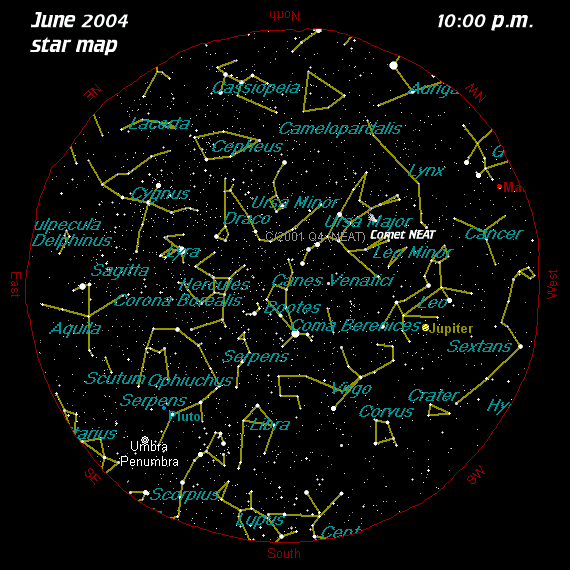



![[Moon Phases]](../moonphases/2004-06-phases.jpg) |
|---|
![]()
![[changing Venus]](5-04-venus-low-high-low.jpg) |
|---|
| Changing Venus: Venus first became prominent as it emerged from the back of the sun in early December 2003 as seen in this Dec. 7 photo, (upper left). By late March, Venus had moved to its greatest elongation west of the sun as seen in the March 27 image (upper right). The bottom picture, taken on May 28, shows Venus as it heads back to pass in front of the sun on June 8. Photography by Gary A. Becker… |
![[Venus Transit Close0ups]](6-04-transit-balanda-closeup.jpg) |
|---|
| And finally, the transit... Mark Balanda of Palmyra, PA took these photographs of Venus transiting the sun from Cabela's near Hamburg on June 8. The photo to right shows the famous black drop effect which made accurate transit timings so very difficult to make. More pictures and the full story will be found below. |
![[Transit Viewing Area at Cabela's]](6-04-transit-viewing-area.jpg) |
|---|
![[Dieruff High School StarWatch Team]](6-04-starwatch-team.jpg) |
|---|
| ASD Planetarium StarWatch members: (from left to right) Caleb Rochelle, Daniel J. Sirotnak, Jesse Leayman, Emily Plessl, Sarabeth Brockley, Gary A. Becker, and Stephen Hopkins practiced their solar moves during Earth Day activities at Hawk Mountain Sanctuary on April 24 in preparation for the June 8, Venus transit. Photo by Susan B. Reisinger-Becker... |
![[Path of Venus across the sun]](6-08-04-venus-transit-shades.gif) |
|---|
| Black Polymer Venus Transit Glasses can be purchased from Dan’s Camera City 1439 W. Fairmont St., Allentown, PA--610-434-2313--for $2.50 per unit. All proceeds will benefit the Allentown School District Planetarium. Venus is drawn to scale in this view of the sun showing where it will be located at the beginning of the transit (sunrise) and at the end. This map is localized for eastern Pennsylvania. |
![[Venus Transit Birthday Cake]](6-04-transit-birthday-cake.jpg) |
|---|
| Thank you Mark Balanda for the perfect birthday cake. |
![[Miriam Levine Venus transit photo]](6-04-miriam-levine-transit.jpg) |
|---|
| Miriam Levine of Allentown captured this exquisite image of the Venus transit from Cabela's in Tilden Township on Tuesday morning, June 8. She used an Olympus digital camera held snugly to a Celestron 32mm eyepiece on an Orion 4.5-inch SkyQuest telescope with an Orion full aperture solar filter. Please feel free to download this image as a souvenir of the June 8 Venus transit with permission from Miriam Levine. |
![[Mark Balanda Venus transit photo]](6-04-transit-balanda-150-5074.jpg) |
|---|
| Mark Balanda of Palmyra, a supporter of the Allentown School District Planetarium's StarWatch program captured Venus in transit and unfiltered at Cabela's on June 8 just as weather conditions started to improve. |
![[Great Summer Triangle Beckons]](6-04-great-summer-triangle.gif) |
|---|
| The Great Summer Triangle is a surefire indication that summer is upon us. Catch it low in the east at 10 p.m. If you are viewing from a rural location, expect to see the hazy star clouds of our Milky Way Galaxy also visible. |
 |
